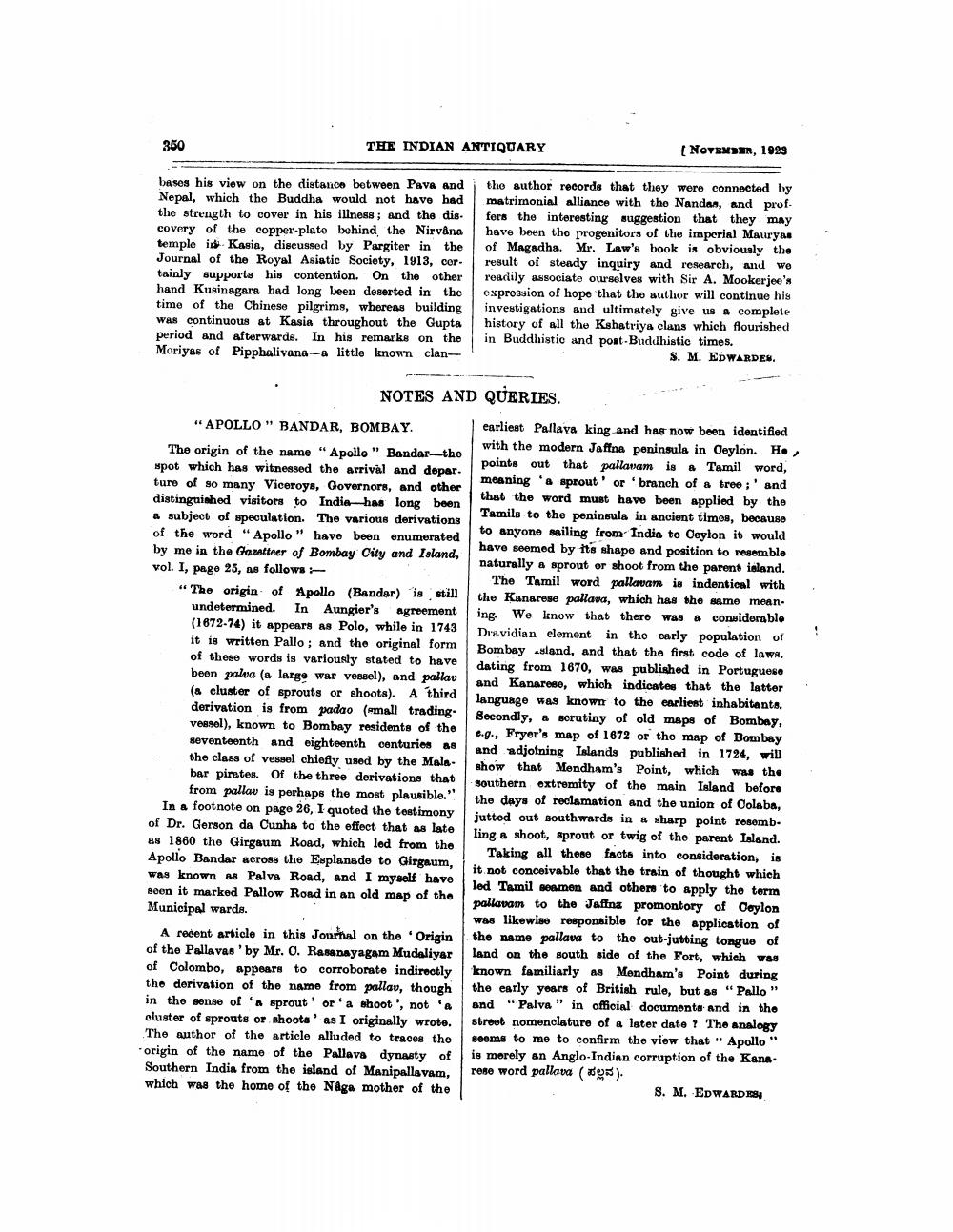________________
350
THE INDIAN ANTIQUARY
bases his view on the distance between Pava and Nepal, which the Buddha would not have had the strength to cover in his illness; and the dis covery of the copper-plate behind, the Nirvana temple in Kasia, discussed by Pargiter in the Journal of the Royal Asiatic Society, 1913, certainly supports his contention. On the other hand Kusinagara had long been deserted in the time of the Chinese pilgrims, whereas building was continuous at Kasia throughout the Gupta period and afterwards. In his remarks on the Moriyas of Pipphalivana-a little known clan
NOTES AND QUERIES.
"APOLLO" BANDAR, BOMBAY.
The origin of the name "Apollo" Bandar-the spot which has witnessed the arrival and depar. ture of so many Viceroys, Governors, and other distinguished visitors to India has long been a subject of speculation. The various derivations of the word "Apollo" have been enumerated by me in the Gazetteer of Bombay City and Island, vol. I, page 25, as follows:
"The origin of Apollo (Bandar) is still undetermined. In Aungier's agreement (1872-74) it appears as Polo, while in 1743 it is written Pallo; and the original form of these words is variously stated to have been palva (a large war vessel), and pallav (a cluster of sprouts or shoots). A third derivation is from padao (small tradingvessel), known to Bombay residents of the seventeenth and eighteenth centuries as the class of vessel chiefly used by the Malabar pirates. Of the three derivations that from pallav is perhaps the most plausible." In a footnote on page 26, I quoted the testimony of Dr. Gerson da Cunha to the effect that as late as 1860 the Girgaum Road, which led from the Apollo Bandar across the Esplanade to Girgaum, was known as Palva Road, and I myself have seen it marked Pallow Road in an old map of the Municipal wards.
A recent article in this Journal on the 'Origin of the Pallavas 'by Mr. O. Rasanayagam Mudaliyar of Colombo, appears to corroborate indirectly the derivation of the name from pallav, though in the sense of a sprout' or a shoot', not a cluster of sprouts or shoots' as I originally wrote. The author of the article alluded to traces the -origin of the name of the Pallava dynasty of Southern India from the island of Manipallavam, which was the home of the Naga mother of the
[NOVEMBER, 1923
the author records that they were connected by matrimonial alliance with the Nandas, and prof fers the interesting suggestion that they may have been the progenitors of the imperial Mauryas of Magadha. Mr. Law's book is obviously the result of steady inquiry and research, and we readily associate ourselves with Sir A. Mookerjee's expression of hope that the author will continue his investigations and ultimately give us a complete history of all the Kshatriya clans which flourished. in Buddhistic and post-Buddhistic times. S. M. EDWARDES.
earliest Pallava king and has now been identified with the modern Jaffna peninsula in Ceylon. He, points out that pallavam is a Tamil word, meaning a sprout or branch of a tree; and that the word must have been applied by the Tamils to the peninsula in ancient times, because to anyone sailing from India to Ceylon it would have seemed by its shape and position to resemble naturally a sprout or shoot from the parent island.
The Tamil word pallavam is indentical with the Kanarese pallava, which has the same meaning. We know that there was a considerable Dravidian element in the early population of Bombay sland, and that the first code of laws. dating from 1670, was published in Portuguese and Kanarese, which indicates that the latter language was known to the earliest inhabitants. Secondly, a scrutiny of old maps of Bombay, e.g., Fryer's map of 1672 or the map of Bombay and adjoining Islands published in 1724, will show that Mendham's Point, which was the southern extremity of the main Island before the days of reclamation and the union of Colaba, jutted out southwards in a sharp point resembling a shoot, sprout or twig of the parent Island.
Taking all these facts into consideration, is it not conceivable that the train of thought which led Tamil seamen and others to apply the term pallavam to the Jaffna promontory of Ceylon was likewise responsible for the application of the name pallava to the out-jutting tongue of land on the south side of the Fort, which was known familiarly as Mendham's Point during the early years of British rule, but as "Pallo " and "Palva" in official documents and in the street nomenclature of a later date? The analogy seems to me to confirm the view that Apollo " is merely an Anglo-Indian corruption of the Kana. rese word pallava ().
"
8. M. EDWARDESĮ




